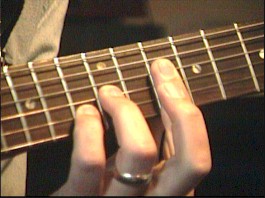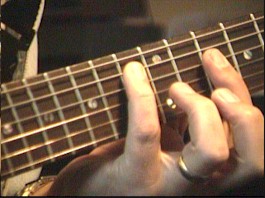
In The Style of Steve Vai - part 3
Intro sample.mp3 (906k)
Lyle: We will be looking examples of the Vai
style through a song called "Shifting Winds" by The Joe Blair Project
off the CD - Watch Out For The Curve. The bass guitar is by Joe Blair, drums by
Jonathan Mover, and all guitars and synths by me. Let's start with the intro lick of
"Shifting Winds". Use a clean sound with a thick "chorus" effect. Set a digital
delay to repeat eighth and quarter note rhythmic echoes if you have one.
Lyle:
I used my guitar synth to overdub an acoustic guitar mixed with strings to
create a rich blend of voices for this
sound. The intro lick uses two chords, Csus2
and Bbmaj7sus2. Learn these first before you learn the intro
lick.
Csus2

Bbmaj7sus2

Lyle:
Here's the intro lick:
intro
lick
Jan: sus2
means that there is a 2nd in the chord instead of 3rd?
Lyle:
Jan, that's right! - maj7 chord=
1-3-5-7, maj7sus2=1-2-5-7, maj7sus4= 1-4-5-7
Lyle:
Here's a jam track you can play along to:
Looping Sound
Clip 1
Lyle: Before we get to the theory part of this
lick, let's look at the production end of
it. Vai, among others, use digital delays on
their guitar signals to "sweeten" the
sound. If you use a digital delay effect on
your guitar, it's very important to have the speed/tempo of the delay
synchronized to the tempo of the song. I recorded this song at a tempo of
122bpm. I wanted a combination of eighth and quarter note delays to echo what I
was playing in the intro lick.
Lyle: The formula to figure out the delay
times is: 60,000 divided by bpm x
length of
note = how many milliseconds to set your delay at.
a length of note value of 2 will give you a
half note echo, or 2 beats worth,
a length of note value of 1 will give you a
quarter note echo,
a length of note value of .5 will give you an
eighth note echo
a length of note value of .75 will give you a
dotted eighth etc.
Lyle: Let's look at an example with this song which is at 122bpm. 60,000 divided by 122bpm x 1 = 491.8ms
will produce a quarter note echo, 60,000 divided by 122bpm x .5 = 245.9ms
will produce an eighth note echo. I used a stereo delay unit on my guitar
for the intro lick. I set the left side at 491.8 with several repeats, and set
the right side at 245.9 with several
repeats. Notice that the intro guitar lick is playing the exact same lick as the
bass, but in a different register of
course.
Lyle: Ok, now a little theory. The intro lick is made up of just two
chords, Csus2 and Bbmaj7sus2. When you have 2 major chords
together, one whole step apart, they most likely are the 4 & 5 chords of a particular
key. In this case, the Csus2 is the 5 chord
and the Bbmaj7sus2 is the 4 chord of the key of F. These two chords are the 4 & 5 in
the key of F maj. Try playing the F major scale over the jam track and you'll
hear how this works.
Lyle:
Since the intro lick progression is centered around the Csus2 chord, the 5 chord
in the key of F, you can use the C mixolydian mode as
well.
Lyle:
Both of these two scales will work over the jam track for your improvisation
practice.
Lyle: The lead guitar part used to play the
melodies in this song has a thick overdrive and longer delay
times. I used a delay setting of 983.6 to
create a 2 beat or half note echo. Formula: 60,000 divided by 122(bpm) x 2
(beats) = 983.6ms. With such a long delay setting, it can
be possible to harmonize with yourself without multi-tracking or
overdubs. Vai uses this type of delay effect in a
couple songs. Check out "Hina" from David Lee Roth's Skyscraper CD, and "The Boy
From Seattle" from Vai's Alien Love Secrets CD. Here's the melody I used for the verse.
It's played over the intro jam track.
Lyle: During the last 2 bars of the verse
lick, you'll be playing a C mixolydian scale, note for note, up the neck to
create a simple melodic phrase which transitions into the pre
chorus.
Lyle: Next is the pre-chorus lick. During this
section, the key has changed. The chords are A to G, back to A. Look at what
type of chords they are and their distance from each other to find out what key
they're in. Two major chords a whole step apart = the 4 and 5 chords of a
key. A is the 5, G is the 4 of D major. This
pre chorus section is now in D major. Check out the lick I played for
this.
pre chorus lick
Lyle:
Listen to this audio sample. It starts with the last 2 measures of the verse
lick, the climbing C mixolydian scale, then into the pre-chorus. This can help
you hear how these two parts fit
together.
pre
chorus sample
Lyle:
You can practice this lick over this jam track.
Looping
Sound Clip 2
Lyle: Next, the chorus lick. This Vai style
lick still uses the long delay setting from the verse. The chorus part in the Vai song
"Touching Tongues" on the Sex and Religion cd inspired me for this type of lick.
This lick uses the notes from the D major pentatonic scale, a 5 tone scale built
from the 1, 2, 3, 5, 6 in the key of D. Here's the scale pattern you can learn
which will help you when it comes time for the chorus
lick.
Lyle:
Once you've learned the D major pentatonic, try this chorus lick:
chorus
lick
Lyle:
The combination of a long delay and sliding notes all synchronized together
create this Vai style lick. Once you learn this lick, try playing it
along to the looping jam track.
Looping Sound Clip 3
Lyle:
Here's an audio sample clip of the chorus:
chorus 1
sample
Lyle:
Next, the song moves right into the solo. It is played over the verse groove
which is back in the key of C mixolydian/ F major.
solo
Lyle: Here's an mp3 sample of
the solo you can listen to:
solo 1
sample
Lyle:
You'll hear the long delay creating several harmonized licks through the solo.
The solo is really pretty simple until the last 4 bars. In bars 13 and 14, you'll play an F maj
scale ascending on the 2nd string with a diatonic 5ths leading the way under
each note of the 2nd string. In bar 15, you'll play a Bb Lydian scale
descending, followed by a C mixolydian scale in the final 16th
bar. Here's a close up video clip of the last 4 bars of the solo.
solo
ending lick
Lyle: Here's a long jam track of all the
sections you just learned. It goes: 16 bar verse, pre-chorus, chorus.
Looping
Sound Clip 4
Lyle:
That wraps up this lesson and series on two of my favorite guitarists. If you
would like further study on this topic or any other topic, email me at
Lyle@theguitar.net for info on how you can get your own customized guitar
lessons like this using Riff Interactive technology. Your private lessons can be
downloaded to your pc for anytime, anywhere study. Thanks and see you at the
next lesson. - Lyle